 Palo Alto Stanford Heritage
Palo Alto Stanford Heritage 25th Holiday House Tour
December 9, 2012: Crescent Park
Homes on tour:
The same New York architect designed this popular American style house, whose lot also borders the Creek - but on two sides. Its garden melds effortlessly with the house to produce a true story-book setting.
What would Freud say about adjacent mother and son houses? Mom lived in this imposingly elegant house, built in 1916 by a well-respected architect who dropped his last name when the United States fought Germany in World War I.
When we think of Prairie Style houses, Frank Lloyd Wright comes to mind. An adaptation of this style sits demurely on a street corner waiting for you to imagine it on Midwestern prairie terrain.
The New York based architect of this house, influenced by the Beaux–Arts tradition, produced a sophisticated building on the banks of San Francisquito Creek. The name of the street on which it is located belies its European aesthetic.
Having barely escaped the wrecking ball, this house has 39 roof ridges, a spectacular stained glass window and is reputed to have been the scene of “orgies” or, at least, of some beatnik bashes.
The rooftop of this manse offered spectacular views of San Francisco, 36 miles away. It was also the site of Palo Alto’s first weather station. It, too, almost met death by demolition.
Originally part of the Rancho Rinconada Del Arroyo de San Francisquito, Crescent Park was first developed in the 1880’s when Timothy Hopkins purchased 698 acres to accommodate Leland Stanford’s “dry” university town. A second wave of development occurred in the early 20’s when realtors Hare, Brewer and Clark sold large lots and set minimum construction costs in an effort to attain houses of architectural merit.
Built between 1904 and 1929, our tour houses range from 4,000 to 7,000 square feet and represent five different architectural styles—Colonial Revival, Classic Revival, French Eclectic/Italianate, English Manor and Prairie.
The rooftop of one manse offered spectacular views of San Francisco, 36 miles away. It was also the site of Palo Alto’s first weather station. It, too, almost met death by demolition.
The same New York architect designed another popular American style house, whose lot also borders the Creek—but on two sides. Its garden melds effortlessly with the house to produce a true story–book setting.
Proof of a beautiful day: This picture was taken at 4:16 p.m!
Palo Alto Stanford Heritage (PAST) Welcomes you to Crescent Park
Crescent Park's boundaries are Middlefield Road to Woodland Avenue and San Francisquito Creek to Channing Avenue. The houses chosen for PAST's 25th Annual Holiday House Tour were built between 1904 and 1929. Each offers lessons in architectural design and in the history of Palo Alto.
In a wealthy community where dreams quickly become reality, it's easy to dismiss the past as irrelevant. Two of our tour houses, 900 and 860 University were once considered irrelevant. The fact that you are viewing them today is due to citizen involvement.
Threatened by demolition in 1973, the Squire House, at 900 University Avenue, was saved by a citizen's committee, led by Gail Woolley. This committee raised $90,000, and the City contributed $118,000 toward restoration. The house ultimately returned to private ownership with a facade easement ensuring preservation of the exterior and the grounds. It is further protected by the Mills Act which gives owners a tax break as long as they allow an annual public tour and do not alter the exterior.
The public campaign to save the Squire House roused general interest in historic preservation in Palo Alto and led to the passage of the City's Historic Preservation Ordinance in 1979. As a result of the Ordinance, a city survey identified 500 historic residences north of Embarcadero and in College Terrace. This list is codified in Palo Alto's Historic Inventory (HI), which ranks houses from 1 to 4 according to architectural and historic merit. The 1979 ordinance also established the Historic Resources Board\ (HRB), which conducts mandatory reviews of any additions or alterations to Category 1 and 2 houses listed on the Historic Inventory. Compliance with the HRB's suggestions is, however, voluntary. A homeowner's decision to demolish an historic building can be appealed, thus delaying demolition for up to one year.
According to Steve Staiger, city archivist/historian, making preservation voluntary is "... why we have some of the problems that we've had." He believes that "Most of the historic buildings that have been identified have no protection." A good example of Staiger's observation was the 2011 demolition of Palo Alto's oldest house, the Juana Briones House, despite the fact that it was "protected" by the Palo Alto's Preservation Ordinance and the Mills Act and was a California Registered Historical Landmark.
The real key to historic preservation is stili citizen involvement. We hope that this tour not only gives you a fresh outlook on the importance of preserving historic buildings but also prompts you to become an activist for preservation.
39 Crescent Drive — 1938
Architect: Leslie I. Nichols
This gracious Colonial Revival house shows the diversity of its architect, Leslie Nichols who also designed the French Eclectic/ltalian Renaissance Revival at 419 Maple Street.
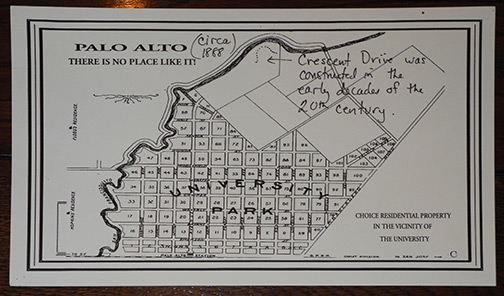
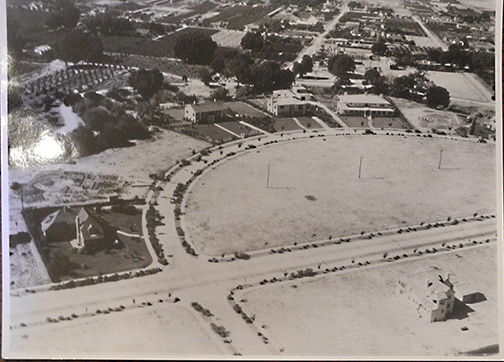
At 4,703 square feet, this two story, wood house sits on 0.8 of an acre which abuts both sides of San Francisquito Creek. Colonial Revival houses were inspired by the practical homes built in colonial America.
Made for entertaining, they feature a welcoming center stair hall with living room on one side, dining room on the other and kitchen and private rooms at the rear.
A fireplace and classical interiors are typical.
Symmetrical facades with a columned entrance portico, sidelights and fanlights and multi–pane, double-hung windows with shutters are the norm. 39 Crescent Drive has these characteristics.
Entering a vine covered gate, we walk along a flower sided brick path to a columned portico. The front door has leaded glass in its sidelights and fanlight. A welcoming foyer has a staircase with a grandfather clock on the landing and a hallway leading to an arched garden door. Note the keystone trim at the dining room entrance and the unusual fiat ceiling trim which is repeated throughout the house. The living room has decorative scrollwork at the fireplace and a curved rear window.
Adjoining is the sunroom with piano, wine cooler and antique game table.
The dining room has decorative wall trim and English Oak "medieval" furniture.
It's difficult to resist the octagonal–shaped breakfast room, whose two alcoves have a shell motif at top and Storage cabinets below.
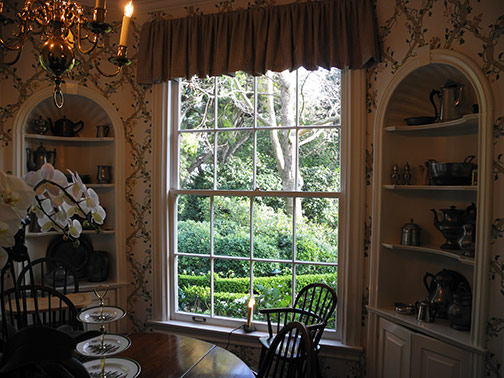
The kitchen, remodeled by the owners, has a coffered ceiling and fireplace.
The hallway leads at one end to a cozy family room, which is lovingly decorated with family photos.
Returning, we enter a serene library with redwood paneling and cabinetry. Note the metal screens at the bookshelves and the unusual, redwood bi–fold doors.
As you leave this house and wander through the lovely garden, you'll be left with the impression of a welcoming family home reflective of the owner and his late wife. Not only did they raise their family here but they contributed enormously to their community. Their service was recognized in 2011 when they were awarded a Lifetime Achievement Award by Avenidas. 39 Crescent Drive is eligible for the Historic Inventory.
855 Hamilton Avenue — 1916
Architect: Charles Sumner
A March 1916 article in the Palo Alto Times boasted that 855 Hamilton Avenue was one of "the year's finest productions in res- idences." Caroline Ray and her son, Robert, built 855 and 865 Hamilton at a cost of $30,000. The Ray family was involved in real estate in Palo Alto and, before 1910, in Duluth, Minnesota where they had also built landmark mother–son houses on the same block.
Charles Sumner, graduate of Columbia University School of Architecture, designed 855 Hamilton. Located on 0.55 of an acre, the house is 6,500 square feet and is an interpretation of an English manor. Sumner built more that fifty houses in Palo Alto; 855 Hamilton was one of the first. Building stylish houses for the comfortable middle class, his residences reflect a certain formality, with separation between private and public spaces and between spaces for the servants and the served. Sumner's houses, built for entertaining, were imbued with a feeling of permanence, restraint and composure, which he deemed elements of beauty.
A brick walkway leads to a wisteria–covered porch and a resplendent red maple. An arched entrance leads to the front door. The door, fianked by glass sidelights, has interior trim with classic dentil molding and carving, which is repeated in the fireplace mantle.
The sun–filled foyer with original quarter–sawn oak floors and a grand staircase, has arched leaded glass windows both at the upper landing and at the steps down to the powder room.
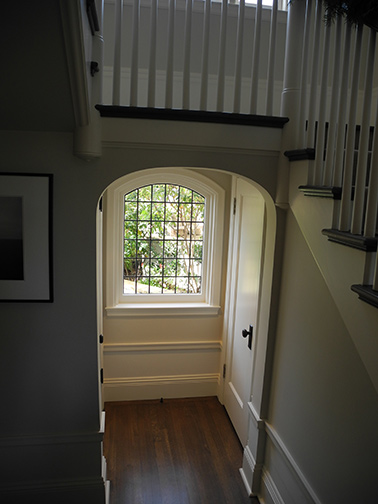
A study to the left, has leaded glass windows, built–in bookcases and paneling. Pocket doors lead to this living room with its original leaded glass front windows and fireplace mantle. The built-in, arched bookcases have bead board backs and are topped by three charming arched windows with diamond–paned lead glass.
Adjacent to the living room is a study, formerly a sun porch, with original windows and latticed paneling.
Oak floors and arched, built–in cabinetry with batten board backs grace the dining room.
Delicate, arched French doors with leaded glass lead to the sunroom, which repeats the arched motif in windows and doors.
The kitchen, formerly used only by servants, was remodeled and expanded in 2006. The original butler's and pastry pantries have been combined. The sunroom and verandah are now one large room.
Charles Sumner believed that it takes both house and garden to make a home.
The beautiful landscaping, pool, spa, tennis court and raised patio with fireplace are certainly an integral part of 855 Hamilton Avenue which is eligible for the Historic Inventory.
975 Hamilton Avenue — 1909
Architect: Unknown
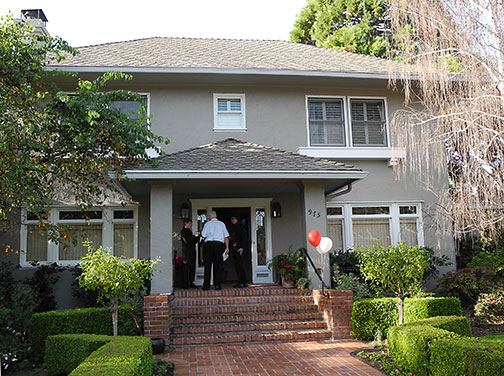
Emma Wolverton, a widow from Winona, Minnesota built this house in 1909 at a cost of $6,000. She lived in Palo Alto until 1942. Architecturally, the house has the symmetry of a Colonial Revival and the bracketed eaves of a Craftsman, but Prairie style features dominate. The Prairie style is one of the few indigenous American styles, originating in Chicago and exemplified by Frank Lloyd Wright. The style flourished and declined between 1900–1920. Its vernacular form was spread throughout the country by pattern books published in the Midwest. Its characteristics were two stories, low-pitched hipped roofs, wide overhanging eaves, a facade emphasizing horizontal lines and massive square porch supports. Ribbon style or clerestory windows and wide baseboards were found in the interior.
A brick path surrounded by formal landscaping leads to the paneled front door with leaded glass sidelights. Entering the foyer, we see a graceful staircase with a built–in storage seat, beautiful oak floors with delicate strips of mahogany and wall paneling.
To the right of the foyer is the warm red dining room with its coffered ceiling, oak flooring with mahogany inlay and paneled walls. Prairie elements are seen in the deep baseboard and in the ribbon style arrangement of both the leaded glass front windows and the smaller side windows. Peek through the dining room door for a glimpse of the kitchen with its gleaming copper pots and hand–made tiles. To the side of the dining room is a charming screened–in porch for reading or sipping tea with a friend.
Returning to the foyer, we enter the living room where all the charming elements of an historic house are evident: coved ceilings, picture rail, upper window sections of leaded glass, deep baseboards and oak flooring. Note the mantel and built-ins at the sides of the fireplace.
A sunny enclosed porch is at the rear of the living room and leads to a private back garden retreat with a lap pool. 975 Hamilton is eligible for Palo Alto's Historic Inventory.
Sue Kemp, pianist
Enjoying the refreshments!
419 Maple Street — 1929
Architect: Leslie I. Nichols
Maple is a common Street name in American towns, evoking simplicity and apple pie. 419 Maple, on a secluded lot facing San Francisquito Creek, belies this stereotype. This two–story stucco house combines elements of the French Eclectic and Italian Renaissance Revival styles. It was built for Maude and Edwin Nichols in 1929 for $34,000. Edwin Nichols was a mining engineer and developer, a pioneer in group insurance and an activist in preserving Yellowstone National Park. The Nichols family moved to Palo Alto in 1921, and it was their son, Leslie Nichols, a New York based architect, who designed 419 Maple and later relocated to the Peninsula. Birge Clark was the on-site architect.
The hipped roof is slate, as is the roof on the porte–cochere. Casement windows are symmetrically placed at the main facade. First floor doors are French style, similar to the windows above. At the corners of each elevation are classically inspired quoins and the upper story windows have a stucco keystone motif. The wood entry door with its clerestory window leads to an entry vestibule with small, oval side windows. There is a second, interior glass door with scrolled wrought iron.
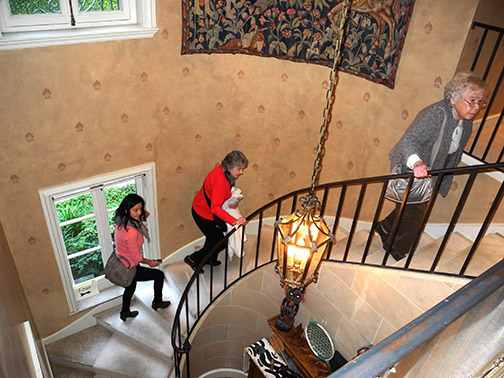
An elegant, circular foyer has a marble floor which repeats the pattern of the original ceiling light.
At the right is an oak paneled office with carved oak detailing and a green marble surround. Above the interior door, we see a charming canvas mural with a pastoral scene. Proceed down a few steps to the breathtaking elegance of the living room with its garden view. The grey marble fireplace, sconces and herringbone parquet floors are original.
The wall trim and dentil molding are new and the original chair rail is expanded. Also new are the steps, columns and leaded glass doors leading to the dining room. The flooring, wallpaper, sconces and door paint plus a white marble fireplace with fioral carving are original features of this room. The elegance of these formal areas leads seamlessly into the warmth of the kitchen and family room. The kitchen footprint is original but the dining and family areas are additions.
A pantried kitchen hallway leads us to the brushed–metal spiral staircase with limestone risers and treads. The stairway molding, chandelier and 2nd floor alcove are original.
The owners added a dramatic vaulted groined ceiling in the master bedroom to reflect the Italianate style of the house. Two original bedrooms can be seen to the right.
The current owners' sensitive remodeling of this innately beautiful house has preserved 419 Maple for generations to come. It is eligible for Palo Alto's Historic Inventory.
860 University Avenue — The Peck Wilson House — 1906
Architects: Frank Delos Wolfe and Charles Mackenzie
When Leland Stanford wanted a "dry" town developed adjacent to his university, he approached Timothy Hopkins. In the 1880's, Hopkins obliged by purchasing 697 acres stretching from San Francisquito Creek to Embarcadero and from the railroad to Woodland. Originally called University Park, the name was changed to Palo Alto at Stanford's request. When lots went on the market in 1890, they sold like hotcakes, and opulent houses like 860 were built.
In 1906, Mr. and Mrs. Elbert Peck hired architects Wolfe and McKenzie, San Jose's most influential firm, to design their house. Within a year, the Pecks sold their house to Dr. Carl and Clara Wilson, whose family resided there until 1975. Between 1975–77, the house was slated for demolition and future condos. A citizens' petition prevented this. Purchasing the house in 1977, the current owners have lovingly restored it.
This two and a half story house is an outstanding example of a version of the Colonial Revival style. Notice the wood frame construction with the upper floor sheathed in narrow clapboard siding and the lower floor in wider clapboard. The roof and dormers are hipped, with a slight flare near the eaves. Wide, shallow steps lead to the front verandah which also embraces both sides. At this entry we see a low gable with a shield and flower relief-ornament. The porch canopy is supported by recessed columns without capitals and appears to float above the ground.
On the northeastern side of the house are two curved bay windows. One projects from the first floor, but the other, a stairwell window, is one and a half stories high and contains elaborately designed art glass. The central panel is a waterfall done in a naturalistic style. Probably the finest window in Palo Alto, its complex design, striking colors and rounded forms are the work of a master.
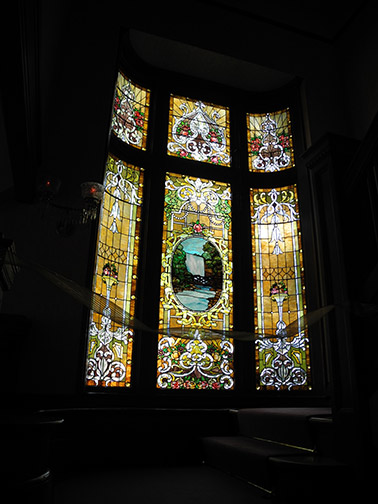
The foyer, parlor, study and dining room are awash in original features such as operable gas sconces, original white oak floors, coved ceilings and Douglas fir trim, doors, cabinetry and paneling. The detailed staircase has egg and dart molding and a curved wood detail at the paneled banister. Leaded glass windows have abstract tulip motifs. Lighting fixtures are original or are authentic period pieces. The living room's mahogany fireplace, installed by the owners, has four columns and a period white marble inset and hearth.
Exiting the porte-cochere, we see lovely pocket gardens. A two-story stable/carriage house is original. 860 University is listed on the National Register of Historic Places and on Palo Alto's Historic Inventory.
900 University Avenue — The Squire House — 1904
Architect: T. Patterson Ross
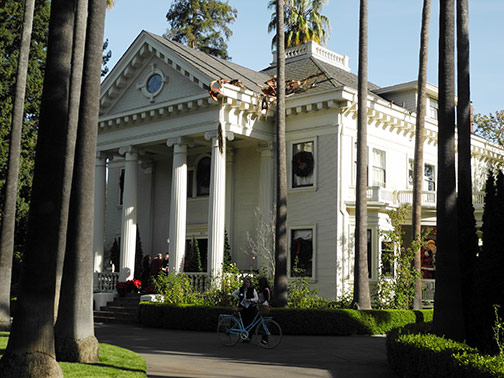
If you were to close your eyes and imagine a house on University Avenue, it would undoubtedly be the Squire House. John Adams Squire, the first owner, was a lecturer in Classics at Stanford and a direct descendant of President John Adams. Heir to the Swift meat–packing fortune, Squire and his wife, Georgiana hired San Francisco architect T. Paterson Ross to build their 7,000 square foot mansion at a cost of $18,000.
This formal wood–clad Classic Roman Revival house proclaimed the owners' interests and economic status. A palm–lined drive leads to the front portico, which is supported by fluted redwood columns with imitative composite capitals and by pilasters. The impressive front entablature and triangular pediment are gabled. The elaborate cornice has massive coffer–type dentils. There is a Roman Palladian window above the front door and an oval leaded glass window in the attic. The widow's walk on the roof provided a spectacular view of San Francisco, 36 miles away.
Behind the formal facade, the house is friendly and comfortable. Standing in the foyer, as soft afternoon light is refracted through leaded glass sidelights and windows, we see a staircase lit by an attic skylight. The 20' x 40' living room has an elegant fireplace with a mahogany mantel replicating the classic columns and design of the front entry. Note the oak and mahogany doors and white oak quarter-sawn floors. Pocket doors separate the rooms, including Mr. Squire's study. A pantried hallway leads from it to the remodeled kitchen.
Original dining room features are oak paneling, beamed ceiling, built-in sideboard and radiators. Adjacent is a comfortable parlor where ladies gathered while their husbands met in the living room. The parlor door leads to the verandah with Tuscan style columns and to the porte-cochere.
To the rear of the verandah, is a traditional garden surrounding a spacious deck with fireplace, a swimming pool and seating areas.
The Squires' gardener, "Chinaman Jim," worked seven days a week maintaining the gardens. Originally one of Jane Stanford's gardeners, he lived in a hut along San Francisquito Creek.
The Squire House is as full of life today as it was Squire girls and their beaus roller–skated in the attic. It is California Registered Landmark No. 457, is listed on the National Register of Historic Places and the Palo Alto Historic Inventory. How 900 University was saved from demolition can be found above.
Baluster — turned or rectangular upright supporting a railing or handrail, a series of these is called a balustrade.
Battern board — wide boards set vertically whose joints are covered by narrow strips of wood (battern) over joints.
Bead board — a narrow, vertical row of planks with a small ridge (bead) between them.
Capital — the head of a column.
Clerestory (Clearstory) — a portion of a window above other windows or doors which admits daylight to the interior.
Chair rail — a horizontal molding fixed to an interior wall about 4-5 feet above the floor. Also called dado rail.
Coffered ceiling — a sunken panel in the ceiling in the shape of a square, rectangle or octagon.
Composite capital — the Roman elaboration of a Greek Corinthian column. Its upper part is Ionic and the lower is Corinthian.
Cornice — the upper and projecting part of an entablature in ClassicaI architecture. A projecting, continuous, prominent horizontal feature located near or at the top of an architectural composition.
Dentil — tooth-like classicaI ornament used in cornices or molding.
Egg and dart molding — decorative molding comprising alternating egg-shaped and dart-shaped motifs.
Entablature — in classicaI architecture, it is that part of a structure between the column capital and the roof or pediment comprising the architrave, frieze and cornice.
| |
E-mail us at either webmaster@pastheritage.org or president@pastheritage.org.
![]() Palo Alto Stanford Heritage—Dedicated to the preservation of Palo Alto's historic buildings.
Palo Alto Stanford Heritage—Dedicated to the preservation of Palo Alto's historic buildings.
Copyright © 2015 Palo Alto Stanford Heritage. All rights reserved.